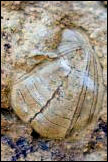Ancient shells tell tale of climate change
|
By studying the chemical composition of ancient marine fossils,
researchers have found new evidence that greenhouse gases such as
carbon dioxide have a big impact on climate.
The researchers used a new method of studying marine fossils to learn temperatures millions of years ago, turning each ancient shell or piece of coral into a climate thermometer.
"All of the information needed to study the surface temperature at the time the animal lived is stored in the fossil itself," said Rosemarie Came of the California Institute of Technology, whose study appears in the journal Nature.
This new method relies on a study of rare clumps of oxygen and carbon isotopes - charged particles - that bond with each other. This bonding varies depending on surface temperature, with more formed at low temperatures and fewer formed at higher temperatures.
By knowing the age of the marine fossil and measuring the concentration of these isotopes, the scientists can tell the temperature of the seawater in which they lived.
"The shell is the thermometer," said John Eiler, a Caltech professor of geochemistry who worked on the study. He said the researchers studied the concentration of these isotopes, which are made up of oxygen-18 and carbon-13 atoms.
"We measure how many are stuck to each other rather than being randomly scattered. That tells us the growth temperature of that fossil," Eiler said.
The method differs from the current approach that involves a study of both the fossil's carbon and oxygen content and the knowledge about the chemistry of ancient seawater.
Using this new method, researchers studied fossil growth temperatures from two ancient time periods to see if changes in atmospheric carbon dioxide are actually linked with temperature change, an important part of understanding climate change.
They studied fossils from the Silurian period about 400 million years ago, during which carbon dioxide levels are believed to have been 10 times higher than at present.
They compared these with fossil temperature readings in the Carboniferous period, roughly 300 million years ago, during which atmospheric carbon dioxide concentrations are thought to have resembled current levels.
"Our study found that in fact there was a huge temperature change - that the time of high carbon dioxide was a time of quite high temperature in tropical oceans, about 34 degrees centigrade (93 F)," Eiler said. "If you got in it, you would think it was a pretty warm bath."
Based on this finding, the researchers believe they have fossil evidence that changes in atmospheric carbon dioxide are associated with changes in temperature.
"It shows that carbon dioxide has been a powerful driver of climate change in the Earth's past," Eiler said.
Source: Reuters News Service



